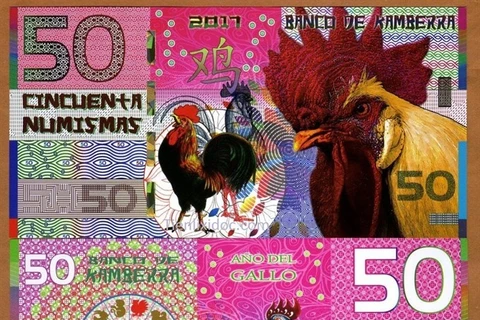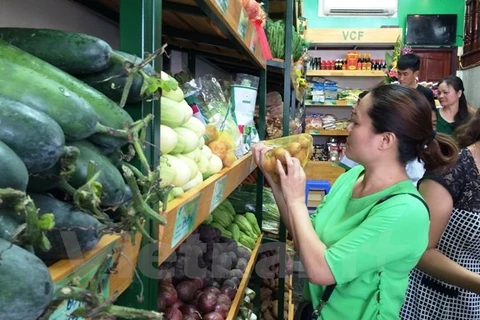HCM City (VNA) - Confectionery giants are struggling to compete for market share during the Tet (Lunar New Year), which falls on January 28.
Big companies like Kinh Do Mondelez, Bibica, Topcake, Hai Ha, Huu Nghi, and Biscafun have launched promotion to attract more customers.
With the slogan “Seeing Kinh Do Means Seeing Tet”, Kinh Do Mondelez has introduced more than 40 confectionery products to serve the Tet market, priced at 40,000-200,000 VND (1.8-8.8 USD) to serve a range of customers.
Vu Quoc Tuan, deputy general marketing and communication director of Kinh Do Mondelez, said Kinh Do began running promotions for Tet since the end of last month.
Bibica has also introduced more than 1,800 tonnes of new confectionery products to the market, a rise of 10 percent over the same period last year.
Most of Bibica’s confectionery products are available at more than 500 stores, supermarkets and 10,000 retail shops nationwide.
Truong Phu Chien, general director of Bibica, said sales had doubled the target after nearly a month of introducing new products.
“Bibica focused on improving product quality and selling Tet products earlier. It has emphasised various segments of products to meet customer demand,” he said.
Meanwhile, Topcake is ready for competition with two major segments, including the high-end segment priced at 100,000-150,000 VND and the low-end segment at 40,000-100,000 VND.
Lam Ngoc Tham, general director of Topcake, said Topcake early last year invested in advanced technology and improved production capacity.
Other well-known brands such as Hai Ha, Huu Nghi and Biscafun are also expected to increase confectionary output by 10 percent to serve the holiday this year.
Business Monitor International (BMI) reported that Vietnam’s confectionery market is expected to generate 40 trillion VND (1.76 billion) in 2018.
BMI pointed to the high market potential in Vietnam, where the average person consumes around two kilos of sweets a year, compared to the global average of 2.8 kilos.
The high growth has attracted many foreign businesses.
The confectionery sector generates 1 billion USD every year in Vietnam and most of the profits go to foreign firms.
Many Vietnamese economists worry that outsiders are taking over the market since local consumers appear to have lost their appetite for locally made cookies, cakes and candies.
Although accounting for more than 70 percent of market share at big supermarkets like Big C, Lotte and Aeon, more and more foreign confectionary brands are present in Vietnam.
Severe competition between local and foreign brands exists in minimarts, retail shops, traditional markets and industrial parks.
There are few major local names to compete with Tous Le Jours, Paris Baguette and Orion from South Korea, Break Talk from Singapore, Mars and Kraft Foods from the US, or Euro Cake from Thailand.
The foreign snack brands import all of their supplies instead of using Vietnamese ingredients.
A representative of Pat’a Chou, a French bakery brand with two outlets in HCM City, said they imported everything from wheat flour to milk powder from Europe.
A vendor at wholesale Binh Tay market in District 6 said it was very difficult to sell local confectionery products as they were not as eye-catching as foreign brands and the selection was quite poor.
“Most of my customers prefer foreign brands,” he said.
Luu Thuy Van, 42, a confectionery importer in HCM City, said customers seemed to prefer foreign confectionery products over local ones.
Imported sweets are becoming more diverse in the high-end segment with famous brands from Europe such as Denmark, France and the UK as well as in the mid-range segment with products made in Thailand and Malaysia.
More and more foreign confectionery companies have invested in local businesses.
For example, the Kinh Do group now belongs to Mondelez International Inc., the maker of Oreo cookies and Ritz crackers after a merger and acquisitions deal.
In addition, Orion Vina was invested in by the Orion group of the Republic of Korea.
To compete with foreign brands, industry insiders said the local confectionery businesses should reform its practices, from packaging to quality to price of products.
Fake and counterfeit products are another challenge faced by local businesses, which has become a serious issue during the Tet holiday.
Nguyen Thanh Phuong, a representative of the HCM City Market Management Division, said counterfeit confectionery products had become a critical issue as it was becoming more difficult to identify counterfeit products.
Counterfeit products are produced not only locally but are also imported, requiring businesses to work more closely with agencies to fight such products, he said.-VNA
Big companies like Kinh Do Mondelez, Bibica, Topcake, Hai Ha, Huu Nghi, and Biscafun have launched promotion to attract more customers.
With the slogan “Seeing Kinh Do Means Seeing Tet”, Kinh Do Mondelez has introduced more than 40 confectionery products to serve the Tet market, priced at 40,000-200,000 VND (1.8-8.8 USD) to serve a range of customers.
Vu Quoc Tuan, deputy general marketing and communication director of Kinh Do Mondelez, said Kinh Do began running promotions for Tet since the end of last month.
Bibica has also introduced more than 1,800 tonnes of new confectionery products to the market, a rise of 10 percent over the same period last year.
Most of Bibica’s confectionery products are available at more than 500 stores, supermarkets and 10,000 retail shops nationwide.
Truong Phu Chien, general director of Bibica, said sales had doubled the target after nearly a month of introducing new products.
“Bibica focused on improving product quality and selling Tet products earlier. It has emphasised various segments of products to meet customer demand,” he said.
Meanwhile, Topcake is ready for competition with two major segments, including the high-end segment priced at 100,000-150,000 VND and the low-end segment at 40,000-100,000 VND.
Lam Ngoc Tham, general director of Topcake, said Topcake early last year invested in advanced technology and improved production capacity.
Other well-known brands such as Hai Ha, Huu Nghi and Biscafun are also expected to increase confectionary output by 10 percent to serve the holiday this year.
Business Monitor International (BMI) reported that Vietnam’s confectionery market is expected to generate 40 trillion VND (1.76 billion) in 2018.
BMI pointed to the high market potential in Vietnam, where the average person consumes around two kilos of sweets a year, compared to the global average of 2.8 kilos.
The high growth has attracted many foreign businesses.
The confectionery sector generates 1 billion USD every year in Vietnam and most of the profits go to foreign firms.
Many Vietnamese economists worry that outsiders are taking over the market since local consumers appear to have lost their appetite for locally made cookies, cakes and candies.
Although accounting for more than 70 percent of market share at big supermarkets like Big C, Lotte and Aeon, more and more foreign confectionary brands are present in Vietnam.
Severe competition between local and foreign brands exists in minimarts, retail shops, traditional markets and industrial parks.
There are few major local names to compete with Tous Le Jours, Paris Baguette and Orion from South Korea, Break Talk from Singapore, Mars and Kraft Foods from the US, or Euro Cake from Thailand.
The foreign snack brands import all of their supplies instead of using Vietnamese ingredients.
A representative of Pat’a Chou, a French bakery brand with two outlets in HCM City, said they imported everything from wheat flour to milk powder from Europe.
A vendor at wholesale Binh Tay market in District 6 said it was very difficult to sell local confectionery products as they were not as eye-catching as foreign brands and the selection was quite poor.
“Most of my customers prefer foreign brands,” he said.
Luu Thuy Van, 42, a confectionery importer in HCM City, said customers seemed to prefer foreign confectionery products over local ones.
Imported sweets are becoming more diverse in the high-end segment with famous brands from Europe such as Denmark, France and the UK as well as in the mid-range segment with products made in Thailand and Malaysia.
More and more foreign confectionery companies have invested in local businesses.
For example, the Kinh Do group now belongs to Mondelez International Inc., the maker of Oreo cookies and Ritz crackers after a merger and acquisitions deal.
In addition, Orion Vina was invested in by the Orion group of the Republic of Korea.
To compete with foreign brands, industry insiders said the local confectionery businesses should reform its practices, from packaging to quality to price of products.
Fake and counterfeit products are another challenge faced by local businesses, which has become a serious issue during the Tet holiday.
Nguyen Thanh Phuong, a representative of the HCM City Market Management Division, said counterfeit confectionery products had become a critical issue as it was becoming more difficult to identify counterfeit products.
Counterfeit products are produced not only locally but are also imported, requiring businesses to work more closely with agencies to fight such products, he said.-VNA
VNA
























